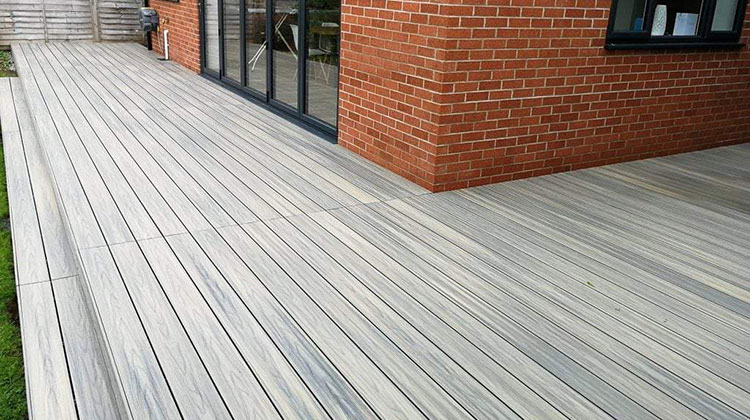
Wood fibres and plastic form the primary component of all composite decking. These materials contribute to the durability and strength of the deck board. Composite decking is alternatively referred to as plastic composite decking, recycled decking, synthetic decking, or Wood-plastic composites (WPC) decking. Most composite decking manufacturers use a mixture of recycled polyethylene and hardwood fibres from reclaimed items. This helps to improve the aesthetic appeal and lessen the environmental impact of the material.
Furthermore, composite decking boards are made from eco-friendly, ethically produced materials that contain no potentially harmful substances that can damage your outdoor space or garden. Other ingredients used in composite decking manufacturing include bonding agents and colour pigment. Because it combines the durable properties of synthetic materials with the functional attributes of wood, composite decking has all of the advantages of wood with the enhanced long-lastingness of 20 years or more.
The process of manufacturing composite decking:
There are two distinct techniques with which composite decking can be manufactured:
Extrusion
This is referred to as a “forming process.” Every kind of wood and plastic is blended to create the final product. Certain colours are added to this blend so that the final composite decking will have the desired visual effect. Also, to ensure the composite plastic decking product is also resistant to decay and rot, the various additives are non-corrosive and very durable. Once the part has been shaped and re-melted, it is returned to the molten state, allowing it to solidify into the final decking board shape. If done regularly, a water system is used to cool the boards after they have been cut to the correct lengths.
Compression Moulding
This method melts the molten mixture, which is applied to a wood grain mould. After being heated to a high temperature, the material is subjected to even more intense pressure before it is allowed to cool. This will help shape the deck. A faux-wood finish can be added once the item has cooled to a certain extent. Through the use of a huge wheel with the pattern, it is possible to configure the machine to go through the motions of inscribing the pattern over the boards repeatedly. To design the composite decking to appear as authentic as possible, most manufacturers use this method.
There are two popular types of composite decking: capped and uncapped. The uncapped composite decks, mostly first-generation composite decks, are prone to fading, discoloration, and mildew growth.
The capped composite deck is of better quality, resilient and long-lasting. This is because their four sides are encased or capped with an extra layer of shield, which improves its quality, enhances its strength, and protects the core of the decking material.
Composite decking vs. wood decking
Composite decking is related to timbre wood decking, but there are some significant differences:
- The likelihood of a splinter or crack is low.
- It is impervious to moisture.
- It is stained and fade-resistant.
- It is low maintenance.
- It is environmentally friendly.
Benefits of composite decking
Composite decking is becoming popular since it provides several benefits. These benefits include:
Easy Installation
Most composite decking boards frequently come with a “groove” system, making it easy to attach the planks. This also helps to save installation time and creates a neat, consistent appearance.
Safety
Composite decking is suitable for pets and bare feet, but hardwood is not. Composite products possess anti-slip features.
Aesthetic Appeal
Composite decking has the aesthetic appeal of traditional wood. It is designed to mimic the appearance of wood.
Environmentally friendly
Composite decking is eco-friendly; it is made from more than 90% recycled and reclaimed materials.

Related stores
Let’s share!


Leave a Reply